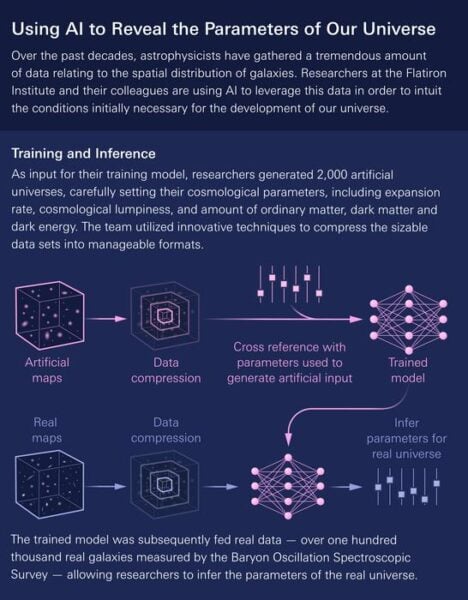Researchers have harnessed the power of artificial intelligence to extract unprecedented detail from galaxy distribution data, leading to more precise estimates of the universe’s fundamental parameters. This breakthrough could help resolve long-standing cosmological puzzles and maximize the value of billion-dollar sky surveys.
AI Dives Deep into Galaxy Data
A team of astrophysicists, including researchers from the Flatiron Institute, has developed a new AI-powered method called Simulation-Based Inference of Galaxies (SimBIG). This innovative approach analyzes the distribution of galaxies in the universe to calculate cosmological parameters with remarkable accuracy.
SimBIG’s estimates are significantly more precise than those produced by conventional techniques using the same data. For example, it reduced the uncertainty in measuring the universe’s matter clumpiness by more than half compared to traditional methods.
Dr. Shirley Ho, a group leader at the Flatiron Institute’s Center for Computational Astrophysics, emphasized the importance of this advancement: “Each of these surveys costs hundreds of millions to billions of dollars. The main reason these surveys exist is because we want to understand these cosmological parameters better.”
Unlocking the Universe’s ‘Settings’
The universe’s behavior on the largest scales is governed by six key numbers, known as cosmological parameters. These parameters describe:
- The amount of ordinary matter
- The amount of dark matter
- The amount of dark energy
- Conditions following the Big Bang
- The opacity of the newborn universe
- The distribution of mass in the cosmos
Liam Parker, a research analyst at the Center for Computational Astrophysics, explains: “These parameters are essentially the ‘settings’ of the universe that determine how it operates on the largest scales.”
Previously, scientists could only analyze the large-scale distribution of galaxies to estimate these parameters. SimBIG breaks new ground by extracting information from small-scale galaxy clustering as well.
Why It Matters
The increased precision offered by SimBIG could help resolve major cosmological debates, such as the Hubble tension. This discrepancy arises from conflicting estimates of how quickly the universe is expanding, based on different measurement techniques.
Dr. ChangHoon Hahn, lead author of the study published in Nature Astronomy, notes: “If we measure the quantities very precisely and can firmly say that there is a tension, that could reveal new physics about dark energy and the expansion of the universe.”
AI Learns from Simulated Universes
The researchers trained their AI model using 2,000 simulated universes from the Quijote simulation suite. Each universe was created with different values for the cosmological parameters. To make the training data realistic, the team even included flaws that mimic imperfections in real galaxy surveys.
This approach allowed the AI to learn how cosmological parameters correlate with both small-scale and large-scale galaxy clustering patterns. The model can analyze the distances between individual galaxy pairs and the shapes formed by groups of three or more galaxies.
After training, the researchers tested SimBIG on real data from 109,636 galaxies measured by the Baryon Oscillation Spectroscopic Survey. The results were impressive, achieving a level of precision equivalent to a traditional analysis using four times as many galaxies.
As new, more comprehensive sky surveys come online in the coming years, SimBIG’s ability to extract maximum information from limited data will be crucial. This method could push the boundaries of our understanding of the universe while maximizing the scientific return on major astronomical investments.


